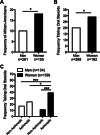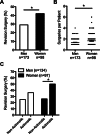A retrospective, cross-sectional study reveals that women with CRSwNP have more severe disease than men
- PMID: 25866636
- PMCID: PMC4386911
- DOI: 10.1002/iid3.46
A retrospective, cross-sectional study reveals that women with CRSwNP have more severe disease than men
Abstract
Up to 50% of patients with chronic rhinosinusitis (CRS) have comorbid asthma, and we have reported that a subset of CRS patients who have nasal polyps (CRSwNP) have elevated autoantigen-specific antibodies within their nasal polyps (NP). While increases in the prevalence and/or severity of both asthma and autoimmunity in women are well characterized, it is not known whether CRSwNP is more severe or frequent in women than men. We sought to determine whether CRSwNP demonstrated sex-specific differences in frequency and/or severity. Using a retrospectively collected database of tertiary care patients (n = 1393), we evaluated the distribution of sex in patients with CRSwNP with or without comorbid asthma or aspirin hypersensitivity. We further compared the severity of sinus disease between men and women with CRSwNP. Although women comprised 55% of CRS patients without NP (CRSsNP), a significantly smaller proportion of CRSwNP patients were female (38%, P < 0.001). Interestingly, women with CRSwNP were significantly more likely than men to have comorbid asthma (P < 0.001), and 61% of patients with the most severe form of disease (aspirin-exacerbated respiratory disease (CRSwNP plus asthma plus aspirin sensitivity)) were women (P < 0.05). Women with CRSwNP were significantly more likely to have taken oral steroids, and were more likely to have a history of revision surgeries (P < 0.05) compared to men. These data suggest that women with CRSwNP have more severe disease than men in a tertiary care setting. Future studies are needed to elucidate the mechanisms that drive disease severity in men and women, paving the way for the development of personalized treatment strategies for CRSwNP based on sex.
Keywords: AERD; asthma; chronic inflammation; chronic rhinosinusitis; oral steroids.
Figures





References
Grants and funding
LinkOut - more resources
Full Text Sources
Other Literature Sources
Miscellaneous

